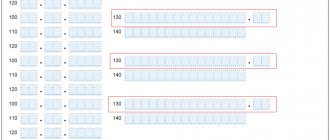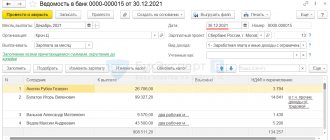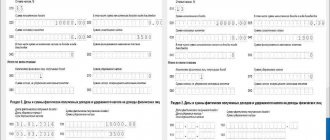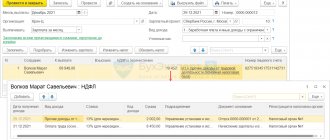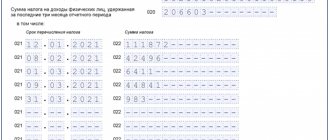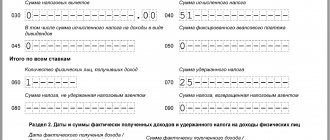Salary advance: terms and definitions
An advance is considered to be part of an employee’s earnings given to him by the employer:
- without fail;
- the force of legal requirements;
- deadlines established by the company itself (taking into account the requirements of labor legislation).
NOTE! The need for advance payment arises from the requirements of labor legislation. Art. 136 of the Labor Code of the Russian Federation requires the employer to pay wages at least every half month, otherwise he faces fines (Article 5.27 of the Code of Administrative Offenses of the Russian Federation) and material losses in the form of interest for late wages (Article 236 of the Labor Code of the Russian Federation).
For more information about the advance, see our article.
Thus, an advance is an element of an employee’s income that is subject to personal income tax and, as a result, has every reason to be included in personal income tax reports, one of which is form 6-NDFL. You will find out whether the advance is reflected in 6-NDFL in the next section.
Procedure and methods for calculating the advance payment
The Ministry of Labor of Russia, in letter No. 14-1/B-765 dated September 18, 2018, explains that the determination of specific terms for payment of wages, as well as its amount for half a month, “are related to legal (collective bargaining) regulation at the institution level.” The letter proposes that when calculating the advance payment, one should rely on Article 129 of the Labor Code of the Russian Federation, which determines the composition of wages. The Ministry of Labor warns that reducing the amount of the advance may be interpreted as discrimination in the world of work. However, at the same time, the letter does not recommend taking into account incentives, compensation and some other types of payments when calculating the advance in order to avoid overpayment.
Based on the explanations, we can draw the following conclusion: since the legislation does not contain restrictions on the amount of the advance, clear calculation conditions must be enshrined in local regulations. And in order to comply with the recommendations given in this and other letters of the Russian Ministry of Labor (for example, dated 02/05/2019 No. 14-1/OOG-549), the advance payment should not be reduced relative to the stated conditions.
In the 1C: Salaries and Personnel Management 8 program, edition 3, an advance can be assigned to an employee in one of three ways (Fig. 2):
- Fixed amount;
- Percentage of the tariff;
- Calculated for the first half of the month.
Rice. 2. Selecting the method for calculating the “Advance”
The method for calculating the advance payment is established and changed in personnel documents Hiring, Personnel transfer, Personnel transfer list, Transfer to another employer, Reinstatement, etc. and in documents changing employee pay: Change in wages, Change in terms of payment for parental leave child, etc.
Assignment of advance payment “Fixed amount”
The Fixed Amount method may be justified for organizations with a small number of employees and with a constant salary. It is essentially an approximate manual pre-calculation of half a month's salary for each employee. This method does not require additional calculations in the program. The advance is formed in the payroll and is paid exactly in the specified amount.
Assignment of advance payment as “Percentage of tariff”
The Percentage of Tariff method historically assumes a value of 40%. This percentage is set in the program by default and represents the average half of the employee’s monthly rate minus 13% (personal income tax, which is subsequently assumed to be withheld). You can set any reasonable calculation percentage. The advance is calculated as a percentage of the employee’s entire payroll fund, i.e. all the employee’s planned accruals that make up the payroll are taken into account. The method allows setting the calculation base for calculating the percentage only simultaneously with a change in the composition of the payroll. The inclusion of accruals in the payroll is set when setting up the Accruals type (see Fig. 3) with the Include in payroll flag. When choosing this option, the specific advance amount is calculated when filling out the payroll.
Rice. 3. Setting up the accrual type
In which line of 6-NDFL is the salary advance reflected?
There is no point in looking for a separate advance line in the report. There is no space allocated for information about the salary advance issued to employees and the personal income tax corresponding to this payment.
6-NDFL for 2022 is submitted using a new form. Use sample 6-NDFL for 2021, compiled by ConsultantPlus experts, and check whether you are filling out everything correctly. This can be done for free by getting trial online access to the system.
This seemingly flaw in the report is actually based on tax legislation, since:
- the employer is obliged to calculate personal income tax on the date of actual receipt of income (this approach is dictated by clause 3 of Article 226 of the Tax Code of the Russian Federation);
- it is necessary to withhold tax from the employee’s salary upon its actual payment (clause 4 of article 226 of the Tax Code of the Russian Federation);
- the date of receipt of income in the form of wages (including advance payments) is the last day of the month for which salary accruals were made (clause 2 of Article 223 of the Tax Code of the Russian Federation, see also letters of the Ministry of Finance dated January 15, 2019 No. 03-04-06/1192, dated 07/13/2017 No. 03-04-05/44802).
Thus, at the time of payment of the advance, it is not yet recognized as income, and therefore there is no need to withhold personal income tax from it. Additional confirmation that information about the advance in 6-NDFL is not reflected in a separate line is the opinion on this matter of federal tax officials, expressed by them in letters dated January 15, 2016 No. BS-4-11/320, dated March 24, 2016 No. BS-4 -11/4999.
For more details, see: “Do I need to pay personal income tax on an advance and when?”
Important to consider! Recommendation from ConsultantPlus: But if the advance is paid on the last day of the month, then in essence it is payment for the month and when paying it, the employer must calculate and withhold personal income tax (clause 2 of Article 223 of the Tax Code of the Russian Federation, Ruling of the Supreme Court of the Russian Federation dated May 11, 2016 No. 309-KG16-1804). In this case, the advance amount in the 6-NDFL calculation is shown as... (for more details, see K+). Trial access to K+ is free.
Despite all of the above, advance payments took place in the reporting quarter, and the question of how to reflect the advance in 6-personal income tax remains open.
Personal income tax and advance: dates and deadlines
The employer must calculate personal income tax on the date of actual receipt of income (clause 3 of Article 226 of the Tax Code of the Russian Federation) and withhold tax from the employee’s wages upon actual payment (clause 4 of Article 226 of the Tax Code of the Russian Federation). For wages (including advance payments), the date of receipt of income is the last day of the month for which the wages were accrued (clause 2 of Article 223 of the Tax Code of the Russian Federation).
Therefore, at the time of payment of the advance, personal income tax is not calculated and not transferred to the budget (Letters of the Federal Tax Service of Russia dated January 15, 2016 No. BS-4-11/320, dated March 24, 2016 No. BS-4-11/4999).
When paying an advance on salary, do not withhold personal income tax. Calculate personal income tax based on the results of the month for which income was accrued (clause 3 of Article 226 of the Tax Code). Withhold the tax when you pay your salary for the month (clause 4 of Article 226 of the Tax Code). The date of receipt of income in the form of salary is recognized as:
- the last day of the month for which it was accrued;
- the last day of work of an employee in the organization if he is dismissed before the end of the month.
How to show a salary advance in the 6-NDFL report: example
Advance payments are still reflected in 6-NDFL, but not in a separate line, but in cells designed to reflect the salary issued. In this case, the salary advance is the legally paid part of the earned income.
Let's show the algorithm for reflecting an advance in 6-NDFL using an example.
Example
Tekhspetsprom LLC started working only in January, and by the end of the 1st quarter, salary accruals amounted to 738,000 rubles. (personal income tax - 95,940 rubles), including:
- On January 22, a salary advance was issued (RUB 300,000);
- On February 4, the final payment for January was made (RUB 438,000).
To simplify the example, we will assume that there are no other accruals and payments during this period.
Filling out 6-NDFL:
- The tax payment deadline (line 021) is 02/07 (postponed from Saturday, February 5);
- The amount of withheld tax payable (line 022) is RUB 95,940;
- The amount of income actually received (line 110, section 2) is 738,000 rubles;
- The amount of calculated tax (line 140, section 2) is 95,940 rubles;
- The amount of tax withheld (line 160, section 2) is 95,940 rubles.
Do I need to indicate an advance in 6-NDFL?
Yes, advance salary accruals are necessarily included in the 6-NDFL calculation lines.
The advance is a part of the salary, it is assigned according to Article 136 of the Labor Code of the Russian Federation for the first part of the month, and is paid in the time period from the 15th to the 30th or 31st of the month for which the advance amount is assigned.
An important point is that since the advance is part of the salary, it is subject to personal income tax. However, taxation is carried out not upon the assignment and payment of income, but together with wages for the second part.
Since taxation for wages for the first and second parts of the month is carried out according to the same rules, at the same time, the advance payment must be reflected in 6-NDFL in the same order as the second part of wages.
The following important dates are set for salary and advance payments:
- actual accrual - the last day of the month for which the accrual was made;
- tax calculation is similar;
- tax withholding - on the day established as the deadline for full payment of wages to employees (from the 1st to the 15th of the next month);
- tax transfer – corresponds to the withholding date or the day following it.
Based on these data, the quarterly calculation form is filled out.
The 6-NDFL calculation is presented in two sections, allowing tax authorities to show what amounts were accrued to workers in the current year, what tax was deducted from income and paid to the budget. The report shows a general picture of the entire staff of the enterprise; it does not contain personalized information on employees.
.
How to reflect the salary for the first half of the month in sections 1 and 2?
Advance amounts for wages are included in separate lines in both sections.
It is important to remember that the first part of the 6-NDFL report shows the results from the beginning of the year to the end of the period for which the calculation is being prepared. Indicators are calculated on an accrual basis. The second part of the report shows data from the last quarter, that is, three months.
The advance, acting as a salary for the first half of the month, must be included in the following lines of section 1:
- 020 - is included in the taxable income accrued before taxation for the months included in the reporting period (for example, the calculation for the 1st quarter of 2022 will include advances for January, February and March 2020). About filling out line 020 6-NDFL;
- 040 - the calculated tax on income from field 020 is shown - this line will also include personal income tax, which is calculated from the advance payment included in field 020 (for example, the calculation for the 1st quarter of 2020 will include the tax on advance amounts assigned for January , February and March 2020);
- 070 - personal income tax deducted from income is shown (the line differs from 040) - the line will include the tax deducted from those advances, the payment date of which fell on the months included in the reporting period (for example, 6-personal income tax for the 1st quarter of 2020 will include the withheld tax from advances for December 2022, January 2022 and February 2022 and the tax deducted from the advance amount for March 2020 will not be included).
The values of fields 040 and 070 may differ. The procedure for filling them out can be found in more detail in this article.
In section 2, the advance will be reflected as follows:
- 100 - the last day of the month in which money was issued to the staff;
- 110 - reflects the date when the remaining wages for the second part of the month were paid;
- 120 - the day when the tax was transferred to the tax authorities;
- 130 - the amount of income that was accrued on the date from line 100 (advance payment and salary for the 2nd part of the same month are shown together);
- 140 - the amount of tax that is collectively withheld from the advance payment and salary for the 2nd part of the same month.
When filling out the second section, you need to pay attention to the following:
- for the month preceding the last quarter, the advance is accrued on the last day of this month, but the tax on it is withheld in the next month, so data on this income must be included in the calculation of 6-NDFL (for example, when generating a report for the 1st half of 2022, entries in the section 2 will begin with information about the advance payment and salary balances for March 2020);
- for the last month of the last quarter, the advance amount is accrued on its last day, but the tax on it will be withheld in the next quarter, therefore the calculation does not include data on the advance calculated for the last month of the reporting or tax period (for example, when compiling 6-NDFL for the 1st half of the year 2022 there is no need to reflect information about the advance and salary for June 2020).
Below is an example for clarity, which explains exactly how to reflect the advance in 6-NDFL.
Example of filling for 2022
6-NDFL is compiled for the first half of 2022. There is only one employee in the company. His salary consists of two parts: for the first half of the month the employee receives 25,000, for the second - 30,000). There are no deductions; apart from the salary, there were no other payments or accruals.
The task is to correctly reflect the advance in the amount of 25,000 in the sections of form 6-NDFL.
Section 1:
- 010 - 13 - this is the rate at which residents’ salaries are taxed;
- 020 - income accrued for January - June 2022 = (25000 + 30000) * 6 months. = 330000;
- 040 - tax calculated on income from line 020 = 13% * 330000 = 42900;
- 060 - 1 person;
- 070 - tax withheld from advance payment and salary for the period December 2022 - May 2022 = 13% * (25000 + 30000) * 6 months) = 42900.
The remaining fields are filled in with zeros due to the lack of indicators to reflect
In this example, fields 040 and 070 coincided, but this does not always happen.
Section 2:
Since 6-NDFL is compiled for six months, this part of the calculation reflects data for the last three months.
Example of reflecting an advance:
The amount of a fixed advance payment in 6-NDFL: how not to make a mistake in terms
We’ve figured out how to show an advance on salary in 6-NDFL. But sometimes it also indicates an advance of a completely different nature, namely: a fixed advance payment (FAP), which is paid by foreigners working on the basis of a patent.
For him, the calculation has a separate line 150 and its own rules of reflection, due to the offset between the personal income tax advance, which is transferred by the employee under the patent, and the tax that the employer has calculated and must transfer to the budget from the income paid to the employee.
Thus, the amount of the FAP in line 150 should not exceed the amount of tax from such employees included in line 140. When the personal income tax paid under a patent is less than the tax calculated on wages, line 150 reflects the entire fixed advance. When more, only a part of it equal to the calculated personal income tax. If the foreigner continues to work and receive a salary, the difference is counted in subsequent periods.
Filling out the calculation in such a situation is discussed line by line in the article “Nuances of filling out 6-NDFL for “patent” foreigners .
